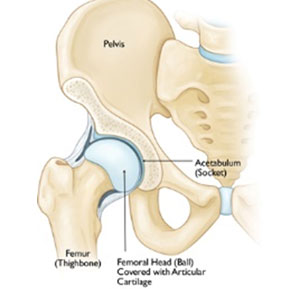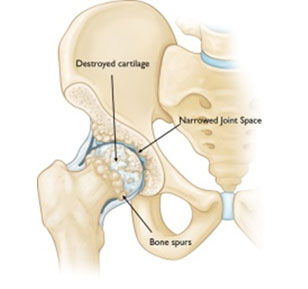What is Osteoarthritis?
Osteoarthritis is the most common form of arthritis. Osteoarthritis occurs when the cartilage that lines your joints wears down over time.
Osteoarthritis is a common condition that many people develop during middle age or older. It can occur in any joint in the body, but most often develops in weight-bearing joints, such as the knee and the hip. It is more commonly understood as the age-related wear and tear of the joint.
Osteoarthritis can affect any joint in your body. Most commonly it affects your
- Hips
- Knees
- Hands
Hip Osteoarthritis
Arthritis is inflammation of one or more of your joints. Pain, swelling, and stiffness are the primary symptoms of arthritis. Any joint in the body may be affected by the disease, but it is particularly common in the knee.
Osteoarthritis of the hip causes pain and stiffness. It can make it hard to do everyday activities like bending over to tie a shoe, rising from a chair, or taking a short walk.
Understanding Hip Joint
The hip is "ball-and-socket" joint. The socket is formed by the acetabulum, which is part of the large pelvis bone. The ball is the femoral head, which is the upper end of the thighbone. The bone surfaces of the ball and socket are covered with articular cartilage, a smooth, slippery substance that protects and cushions the bones and enables them to move easily. The joint is covered by a thin lining called the synovium which produces a small amount of fluid that lubricates the cartilage and aids in movement.
In osteoarthritis, the cartilage in the hip joint gradually wears away over time. As the cartilage wears away, it becomes frayed and rough, and the protective joint space between the bones decreases. This can result in bone rubbing on bone. To make up for the lost cartilage, the damaged bones may start to grow outward and form bone spurs (osteophytes).


What is Hip Osteoarthritis?
Hip Osteoarthritis is a degenerative, wear-and-tear that occurs as we grow older. It can affect a wide range of age group, but is generally more symptomatic in elderly population. As the cartilage wears away, it becomes frayed and rough. The space between the thigh and the shin bones decreases. This can result in the ball and the socket rubbing against each other and deformation of the congruent shape of the ball and the socket.
Causes
Osteoarthritis has no single specific cause, but there are certain factors enlisted below that may make you more likely to develop the disease. Even if you do not have any of the risk factors listed above, you can still develop osteoarthritis.
- Increasing age
- Family history of osteoarthritis
- Previous injury to the hip joint
- Obesity
- Improper formation of the hip joint at birth, a condition known as developmental dysplasia of the hip
Symptoms
- Pain in your groin or thigh that radiates to your buttocks or your knee
- Pain that flares up with vigorous activity and cold weather
- Pain when pressure is placed on the hip
- Stiffness in the hip joint that makes it difficult to walk or bend
- "Locking" or "sticking" of the joint, and a grinding noise (crepitus) during movement
- Decreased range of motion in the hip that affects the ability to walk and may cause a limp
- Tenderness about the hip
- Problems with your gait (the way you walk)
Imaging Tests
- X-rays
- Other imaging tests – MRI, CT scan or Bone Scan may be requested by your treating surgeon to make an accurate diagnosis or rule out other conditions.
- Laboratory Tests – Your treating surgeon may also recommend blood tests to determine which type of arthritis you have. With some types of arthritis like rheumatoid arthritis, blood tests will help with a proper diagnosis.
Treatment
Nonsurgical Treatment
Early treatment of osteoarthritis of the hip is nonsurgical. Your doctor may recommend a range of treatment options.
- Lifestyle modifications- Some changes in your daily life can protect your hip joint and slow the progress of osteoarthritis.
- Minimizing activities that aggravate the condition, such as climbing stairs.
- Switching from high-impact activities (like jogging or tennis) to lower impact activities (like swimming or cycling) will put less stress on your hip.
- Losing weight can reduce stress on the hip joint, resulting in less pain and increased function.
- Physical therapy – Specific exercises can help increase range of motion and flexibility, as well as strengthen the muscles in your hip and leg. Your doctor or physical therapist can help develop an individualized exercise program that meets your needs and lifestyle.
- Orthotic Aids – Using walking supports like a cane, crutches, or a walker can improve mobility and independence.
- Medications – If your pain affects your daily routine, or is not relieved by other nonsurgical methods, your doctor may add medication to your treatment plan.
- Pain Killer - Over-the-counter pain killers are usually the first choice of therapy for arthritis of the knee. Like all medications, over-the-counter pain relievers can cause side effects and interact with other medications you are taking. Please discuss the use of pain killers with your treating surgeon to fully understand the potential side-effects.
- Intra-articular (Within the joint) Injections - Corticosteroids (also known as cortisone) can be injected into the joint. These injections provide pain relief and reduce inflammation; however, the effects are temporary and repeated use can lead to potential long term damage to the cartilage of the joint. Your doctor may recommend limiting the number of injections to three or four per year, per joint, due to possible side effects.
Surgical Treatment
Your doctor may recommend surgery if your pain from arthritis causes disability and is not relieved with nonsurgical treatment
- Osteotomy- Either the head of the thighbone or the socket is cut and realigned to take pressure off of the hip joint. This procedure is used only rarely to treat osteoarthritis of the hip.
- Hip resurfacing –In this hip replacement procedure, the damaged bone and cartilage in the acetabulum (hip socket) is removed and replaced with a metal shell. The head of the femur, however, is not removed, but instead capped with a smooth metal covering
- Total hip replacement. –Your doctor will remove both the damaged acetabulum and femoral head, and then position new metal, plastic or ceramic joint surfaces to restore the function of your hip.
